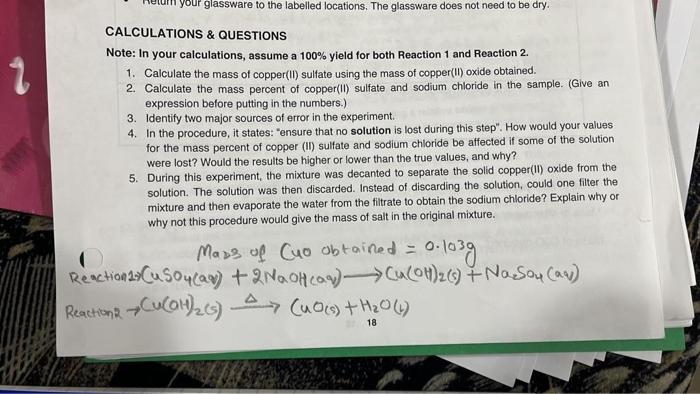CALCULATIONS & QUESTIONS Note: In your calculations, assume a 100% yield for both Reaction 1 and Reaction 2. 1. Calculate the mass of copper(II) sulfate using the mass of copper(lt) oxide obtained 2. Calculate the mass percent of copper(II) sulfate and sodium chloride in the sample. (Give an expression before putting in the numbers.) 3. Identify two major sources of error in the experiment. 4. In the procedure, it states: "ensure that no solution is lost during this step". How would your values for the mass percent of copper (II) sulfate and sodium chloride be affected if some of the solution were lost? Would the results be higher or lower than the true values, and why? 5. During this experiment, the mixture was decanted to separate the solid copper(ll) oxide from the solution. The solution was then discarded. Instead of discarding the solution, could one filter the mixture and then evaporate the water from the filtrate to obtain the sodium chloride? Explain why or why not this procedure would give the mass of salt in the original mixture. Mass of Cuo obtained = ( : 0.1039 Ha 1 your glassware to the labelled locations. The glassware does not need to be dry. CALCULATIONS & QUESTIONS Note: In your calculations, assume a 100% yield for both Reaction 1 and Reaction 2. 1. Calculate the mass of copper(II) sulfate using the mass of copper(II)oxide obtained. 2. Calculate the mass percent of copper(II) sulfate and sodium chloride in the sample. (Give an expression before putting in the numbers.) 3. Identify two major sources of error in the experiment 4. In the procedure, it states: "ensure that no solution is lost during this step". How would your values for the mass percent of copper (II) sulfate and sodium chloride be affected if some of the solution were lost? Would the results be higher or lower than the true values, and why? 5. During this experiment, the mixture was decanted to separate the solid copper(II)oxide from the solution. The solution was then discarded. Instead of discarding the solution, could one filter the mixture and then evaporate the water from the filtrate to obtain the sodium chloride? Explain why or why not this procedure would give the mass of salt in the original mixture. Mass of Cuo obtained = 0.11 0.1039 Reactions cu soucas) + 2Nachcam) > Cu(OH)20) Nasou can) Reaction & CUCH)2(s) CuO(s) + HO (4) 18








